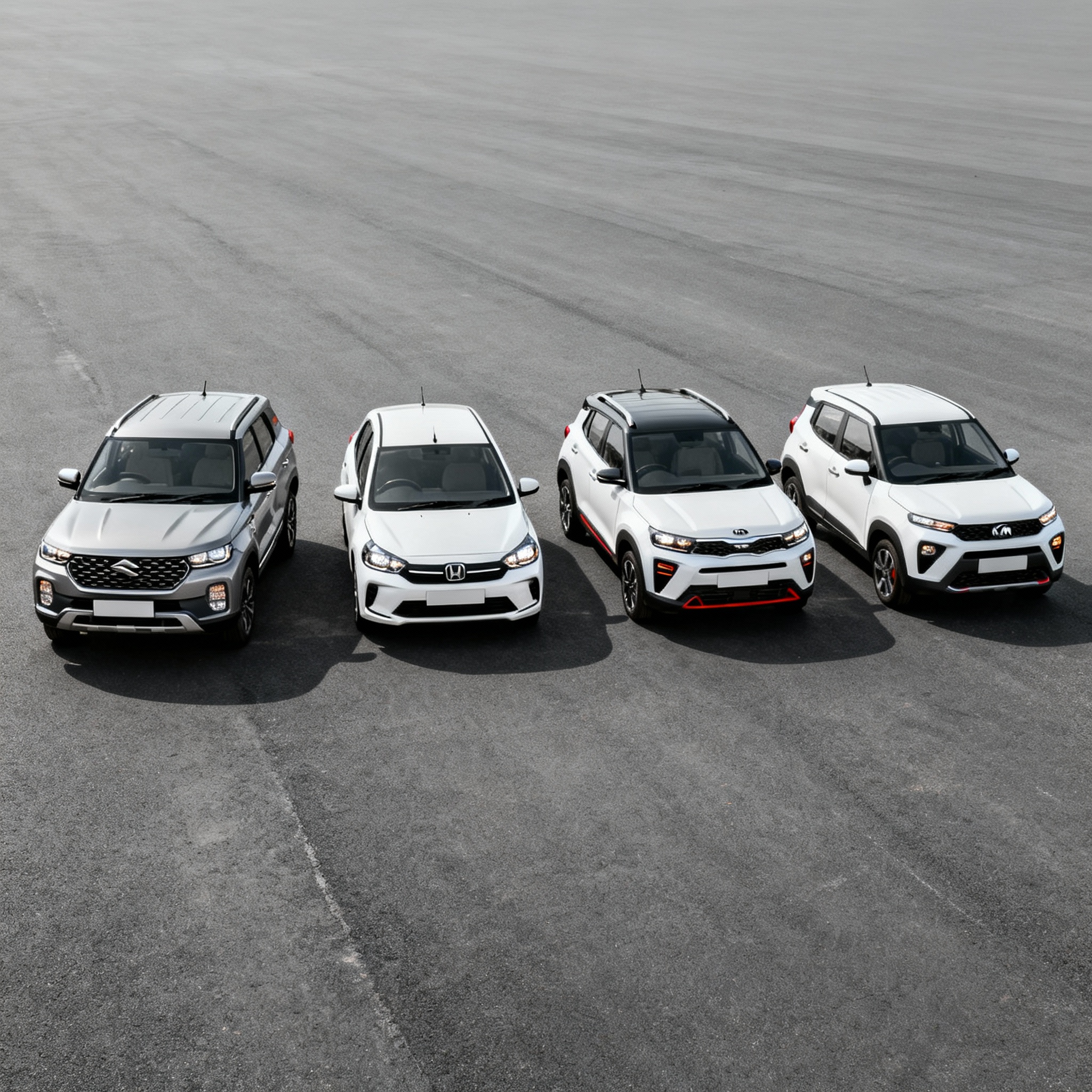
#कारडिस्काउंट #ऑटोसेक्टर #ग्रामीणभारत #टूव्हीलरबिक्री #बजट2025 #इलेक्ट्रिकवाहन#CarDiscounts #AutoSector #RuralIndia #TwoWheelerSales #Budget2025 #ElectricVehicles
Combined Short Heading
कारों पर भारी छूट, ग्रामीण भारत में टू-व्हीलर बिक्री मजबूत | Steep Car Discounts, Rural Two-Wheeler Sales Hold Firm
हिंदी आर्टिकल
परिचय
2025 के पहले छह महीनों में भारतीय ऑटोमोबाइल सेक्टर में दो अलग-अलग ट्रेंड्स देखने को मिले। एक तरफ कार कंपनियां भारी छूट देकर अपनी इन्वेंट्री क्लियर करने में जुटी रहीं, वहीं दूसरी ओर ग्रामीण भारत में दोपहिया वाहनों की मांग में मजबूती बनी रही। यह लेख इन दोनों ट्रेंड्स, उनके कारणों, बजट के प्रभाव और भविष्य की संभावनाओं पर विस्तार से प्रकाश डालता है।
कारों पर भारी छूट: कारण और असर
2025 के H1 में टाटा मोटर्स, हुंडई, महिंद्रा, मारुति सुजुकी, किआ, स्कोडा, रेनो, जीप जैसी कंपनियों ने अपने कई मॉडल्स पर ₹70,000 से लेकर ₹4 लाख तक की छूट दी। EV और SUV सेगमेंट में यह छूट सबसे ज्यादा रही। डीलरों के पास 50-55 दिनों की इन्वेंट्री थी, जिससे उन पर दबाव बढ़ा और उन्होंने गाड़ियों को बेचने के लिए आक्रामक डिस्काउंट ऑफर किए।डीलरों को दो महीने से ज्यादा इन्वेंट्री रखने पर 2% तक की होल्डिंग कॉस्ट चुकानी पड़ती है, जिससे वे छूट देने को मजबूर हुए।
-
हुंडई Ioniq 5 पर ₹4 लाख तक की छूट
-
महिंद्रा XUV700 और Scorpio N पर ₹4.1 लाख तक की छूट
-
मारुति, किआ, स्कोडा, रेनो, जीप के कई मॉडल्स पर ₹1-3 लाख तक के ऑफर
-
किआ सेल्टॉस, सोनेट, कैरेन्स पर भी आकर्षक छूट
-
मारुति जिम्नी, थार, आयोनिक 5 EV, ब्रेज़ा, स्विफ्ट, ऑल्टो K10 आदि पर भी ऑफर
इन छूटों का मुख्य कारण डिमांड में सुस्ती, इन्वेंट्री का बढ़ना और नए मॉडल्स के लॉन्च से पुरानी गाड़ियों की बिक्री में गिरावट है।
ग्रामीण भारत में टू-व्हीलर बिक्री मजबूत
जहां कार कंपनियां छूट देकर बिक्री बढ़ाने की कोशिश कर रही हैं, वहीं दोपहिया वाहन कंपनियों ने छूट देने में सतर्कता बरती। बजाज, हीरो, टीवीएस, होंडा, यामाहा जैसी कंपनियों ने सीमित ऑफर दिए, क्योंकि ग्रामीण बाजारों में मांग स्थिर रही।
-
ग्रामीण क्षेत्रों में दोपहिया वाहनों की बिक्री में 8% से ज्यादा की वृद्धि
-
शहरी क्षेत्रों की तुलना में ग्रामीण इलाकों में डिमांड ज्यादा
-
एंट्री लेवल (110-125cc) बाइक्स की बिक्री में 12.7% की बढ़ोतरी
-
ग्रामीण मांग को मजबूत मानसून, कृषि आय, और आसान फाइनेंसिंग ने सपोर्ट किया
-
शादी, त्योहार और रबी फसल के बाद ग्रामीण इलाकों में बिक्री में तेजी
ग्रामीण बाजारों में टू-व्हीलर की मांग भारतीय अर्थव्यवस्था के लिए शुभ संकेत है, क्योंकि इससे ग्रामीण आय और उपभोग क्षमता में वृद्धि का पता चलता है।
बजट 2025 का असर
2025 के बजट में ऑटो सेक्टर के लिए कई सकारात्मक घोषणाएं की गईं:
-
इनकम टैक्स छूट सीमा बढ़ाकर ₹12 लाख की गई
-
EV बैटरी प्रोडक्शन पर कस्टम ड्यूटी माफ
-
धन-धान्य कृषि योजना से ग्रामीण वाहन मांग को बूस्ट
-
MSME के लिए आसान लोन
-
EV, ग्रीन मोबिलिटी और चार्जिंग इन्फ्रास्ट्रक्चर को बढ़ावा
-
रोड और हाईवे विस्तार से वाहन बिक्री को सपोर्ट
इन घोषणाओं से उपभोक्ताओं की क्रय शक्ति बढ़ी, जिससे कार और टू-व्हीलर दोनों की बिक्री को सपोर्ट मिला।
बाजार की स्थिति और आगे की संभावनाएं
-
जनवरी से मई 2025 के बीच पैसेंजर व्हीकल रिटेल सेल्स में 2.5% की वृद्धि
-
टू-व्हीलर रिटेल सेल्स में 0.14% की मामूली बढ़ोतरी, लेकिन ग्रामीण इलाकों में डिमांड स्थिर
-
एंट्री लेवल बाइक्स की हिस्सेदारी बढ़ी
-
EV सेगमेंट में भी छूट और सरकारी प्रोत्साहन से बिक्री में तेजी
-
RBI की ब्याज दर कटौती से फाइनेंसिंग आसान हुई
-
मानसून अच्छा रहा तो ग्रामीण मांग और बढ़ सकती है
विशेषज्ञों का मानना है कि आने वाले महीनों में कार कंपनियां अपनी इन्वेंट्री को संतुलित करने के लिए प्रोडक्शन घटा सकती हैं, जबकि टू-व्हीलर कंपनियां ग्रामीण मांग के भरोसे आगे बढ़ेंगी।
निष्कर्ष
2025 के पहले छह महीनों में भारतीय ऑटो सेक्टर में दो विपरीत ट्रेंड्स देखने को मिले—कारों पर भारी छूट और ग्रामीण भारत में टू-व्हीलर की मजबूत बिक्री। बजट, सरकारी नीतियां, ग्रामीण आय, और बाजार की स्थिति इन ट्रेंड्स को प्रभावित कर रही हैं। आने वाले समय में भी यह ट्रेंड जारी रहने की संभावना है, खासकर अगर ग्रामीण अर्थव्यवस्था मजबूत बनी रही।
English Article
Introduction
The first half of 2025 has revealed two contrasting trends in India’s automobile sector. While carmakers have resorted to steep discounts to clear unsold inventory, two-wheeler sales have remained robust, especially in rural India. This article explores the reasons behind these trends, the market situation, the impact of the Union Budget, and future prospects.
Steep Car Discounts: Reasons and Impact
In H1 2025, major automakers like Tata Motors, Hyundai, Mahindra, Maruti Suzuki, Kia, Skoda, Renault, and Jeep offered discounts ranging from ₹70,000 to ₹4 lakh on various models, especially in the EV and SUV segments. Dealers faced inventory levels of 50–55 days, leading to aggressive discounting to avoid holding costs.
-
Hyundai Ioniq 5: up to ₹4 lakh off
-
Mahindra XUV700 and Scorpio N: up to ₹4.1 lakh off
-
Maruti, Kia, Skoda, Renault, Jeep: ₹1–3 lakh discounts on select models
-
Kia Seltos, Sonet, Carens: attractive offers
-
Maruti Jimny, Thar, Ioniq 5 EV, Brezza, Swift, Alto K10: special deals
The main reasons for these discounts are sluggish demand, high inventory, and the launch of new models making older stock harder to sell.
Two-Wheeler Sales Hold Firm in Rural India
While carmakers are pushing discounts, two-wheeler manufacturers have been cautious with offers. Companies like Bajaj, Hero, TVS, Honda, and Yamaha have limited their incentives, as rural demand has remained stable.
-
Over 8% growth in rural two-wheeler sales
-
Rural demand outpaces urban
-
Entry-level (110–125cc) bikes see 12.7% growth
-
Strong monsoon, agricultural income, and easy financing support rural demand
-
Wedding, festival, and post-harvest seasons boost sales in villages
Rural two-wheeler demand is a positive sign for the Indian economy, reflecting rising rural incomes and consumption capacity.
Impact of Budget 2025
The 2025 Union Budget brought several positives for the auto sector:
-
Income tax exemption limit raised to ₹12 lakh
-
Customs duty waived on EV battery production
-
Dhan-Dhaanya Krishi Yojana to boost rural vehicle demand
-
Easier loans for MSMEs
-
Focus on EVs, green mobility, and charging infrastructure
-
Road and highway expansion to support vehicle sales
These measures have increased consumer purchasing power, supporting both car and two-wheeler sales.
Market Status and Future Outlook
-
Passenger vehicle retail sales up 2.5% (Jan–May 2025)
-
Two-wheeler retail sales up 0.14%, with rural demand steady
-
Entry-level bikes’ share rising
-
EV segment sales accelerating due to discounts and government incentives
-
RBI rate cuts have made financing easier
-
A good monsoon could further boost rural demand
Experts believe carmakers may reduce production to balance inventory, while two-wheeler makers will continue to rely on rural demand.
Conclusion
The first half of 2025 has seen two divergent trends in India’s auto sector—steep car discounts and strong rural two-wheeler sales. Budgetary measures, government policies, rural income, and market dynamics are shaping these trends. The outlook remains positive, especially if the rural economy continues to strengthen.







